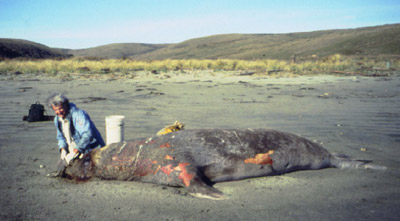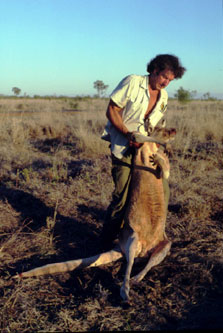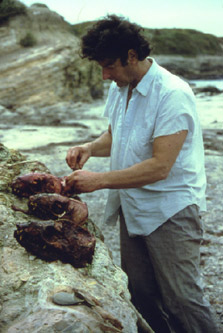Skulls and Bones
Air Date: Week of August 8, 2003
Bones are repositories of history. But beachcomber Ray Bandar has been collecting them for forty years for beauty as well as what they reveal. Rosemary Hoban reports from San Francisco that science says thank you to a hobby run amok.
Transcript
CURWOOD: Further up the California coast, San Francisco native Ran Bandar can be found at the beach. Summer, fall, winter and spring, he combs the shore in an unusual quest. Ray’s hobby is retrieving skulls and bones from the dead marine mammals that wash ashore. Reporter Rose Hoban recently followed Ray out to the beach and she prepared this report.
[BEACH SOUNDS]
HOBAN: When most people see a dead animal on the beach, they give it a wide berth. Not Ray Bandar. When he comes across the decaying carcass of an elephant seal, he heads straight for it and sets down his knapsack full of tools.
BANDAR: I bring a bunch of knives and a sharpener and a little fork to scoop out brain tissue.
HOBAN: Ray snaps on a pair of latex gloves and sizes up the situation.
BANDAR: Oh, this guy’s been dead for weeks, and probably floating most of that time.

Ray Bandar and an adult female Stellar Sea Lion, Ano Nuevo Island, California, 1963.
HOBAN: Then Ray gets to work cutting away at rotting flesh to reach the bones underneath. It takes time. The seal was a full-grown male, about 12 feet long, and easily weighed several thousand pounds. He has only one thing in mind: getting that skull.
The smell makes me choke, but Ray doesn’t even notice anymore. That’s because he’s been cutting skulls off of dead animals since the Eisenhower administration.
BANDAR: Well, I’ve collected, well, more than 6,000 animals easy. I’ve cut up and collected the skulls from more California sea lions than any other person alive.
HOBAN: It’s hard to believe this all started with one skull back in 1953. Ray was in art school and was studying Georgia O’Keefe and German photographer Andres Feineger, both of whom had given him an appreciation of bones as sculpture.
BANDAR: Bones are beautiful. They’re fantastic pieces of sculpture. And so once they’re cleaned up, God…they’re art pieces. But they also can tell you a functional story about the life of the animal.
HOBAN: Ray eventually became a high school biology teacher and he continued to collect bones during his spare time. Now, after 40 years of beachcombing, his tall frame and tattered blue field jacket are familiar to wildlife authorities all along the California coast. Perhaps what’s startling is that most of his vast collection is stored at his San Francisco home.
BANDAR: The house is actually an art museum and natural history museum. And a bone palace.
HOBAN: Where do you live in your house?
BANDAR: Oh, I have plenty of place to live. There are bones on all three levels, and the third level has thousands of skulls on display.
HOBAN: Ray shows off the sculptural qualities of bones throughout the house, from abstract pelican pelvises over the fireplace to snake skeletons curled up in glass cases. In Ray’s house, bones are art and bones are humor. There’s a set of moose antlers in the bathtub and a ceramic cup full of penis bones on the dining room table.
But Ray doesn’t collect just for himself. In fact, that would be illegal. He has permission from the California Academy of Sciences in San Francisco to collect, and his findings are donated, at least in spirit. Because Ray’s home is actually an official annex of the academy.
LONG: One of the reasons why Ray has such a huge number of specimens at his house is because we don’t have the room here to store them.
HOBAN: Douglas Long is the head of ornithology and mammalogy at the Academy of Sciences. Last year when the academy made plans to renovate, Long knew they needed to accommodate Ray’s bones. So he sent architects to Ray’s house to take measurements.
LONG: I didn’t tell these people what they were going to run into, and I knew that they would be completely blown away by what they saw. And it was about 10, maybe 15 minutes before their jaws become un-slackened.
HOBAN: Long says a collection like Ray’s is invaluable to science. In just the past year researchers have taken tiny drillings from teeth in Ray’s sea lion skulls to study environmental toxins. Other scientists compared chemicals in the sea lion teeth from before and after an El Nino to examine changes in the animals’ diets.
LONG: People have come up with some fantastic ways of looking for scientific information from these specimens, so there are techniques that will come up in the future that we have no idea now. Who knew about DNA a hundred years ago? Who knew about isotopic chemical analysis from teeth ten years ago?
HOBAN: Over the years Douglas Long has learned to defend Ray’s hobby and what some people see as his weird, relentless search for dead animals.
 |
 |
|
| Ray Bandar holds a 7 1/2 foot Red Kangaroo that was found dead on a road in Queensland, Australia, 1981. (Photo: Alkmene Bandar) | Ray Bandar cleans one of three male California Sea Lion skulls, Ano Nuevo Island, California, circa 1970’s.
LONG: I think he’s weird because he doesn’t have a TV, doesn’t have a computer, doesn’t drink alcohol, doesn’t gamble, doesn’t even eat junk food unless it’s free, and I think that is probably the weirdest thing about him. I think there’s absolutely nothing weird about having the drive to understand nature and to collect scientific information for our institution. That’s normal.
HOBAN: For Ray, collecting has been almost an act of faith. He has no way of knowing what use scientists will find for these bones, these studies in shape and light. They have been his life’s work and they’re his gift to the future. Now Ray’s legacy is on display at the California Academy of Sciences. And soon there will be a permanent space dedicated to his collection. But he has no intention of resting. BANDAR: In a month and a half I’ll be 75. HOBAN: So, isn’t it time to quit? BANDAR: Hell no. As long as my legs still hold up and there’s still stuff on the beaches, I’m going to work the beaches. As long as there’s still stuff to get from the zoos, I’ll be collecting stuff. HOBAN: At this rate, the academy had better plan a big extension. For Living on Earth, I’m Rose Hoban in San Francisco. [MUSIC: Richard Warner “Spirit Wind” Quiet Heart/Spirit Wind Enso Records (1996)] CURWOOD: This month you can hear author Sy Montgomery read from her new book “Search for the Golden Moon Bear” on the Living on Earth website. MONTGOMERY: In glossy monsoon soils they leave their footprints. With five rounded toes and a long heel pad on the back foot, their footsteps look like those of giant humans. But you could spend years exploring these tangled rainforests and never see a moon bear. Instead, you would find them, as we did, caged in back of tourist hotels, chained outside of city pharmacies, and at markets like this one. CURWOOD: It’s the search for the golden moon bear, all this month on our website, livingonearth.org. That’s livingonearth.org. [MUSIC] And you’re listening to NPR’s Living on Earth. FEMALE ANNOUNCER: Funding for Living on Earth comes from the World Media Foundation Environmental Information Fund. Major contributors include the Town Creek Foundation and the Wellborn Ecology Fund. Support also comes from NPR member stations and Bob Williams and Meg Caldwell, honoring NPR’s coverage of environmental and natural resource issues and in support of the NPR President’s Council; and Paul and Marcia Ginsberg, in support of excellence in public radio. Living on Earth wants to hear from you!Living on Earth Newsletter [Click here]
Donate to Living on Earth! NewsletterLiving on Earth offers a weekly delivery of the show's rundown to your mailbox. Sign up for our newsletter today!
|





